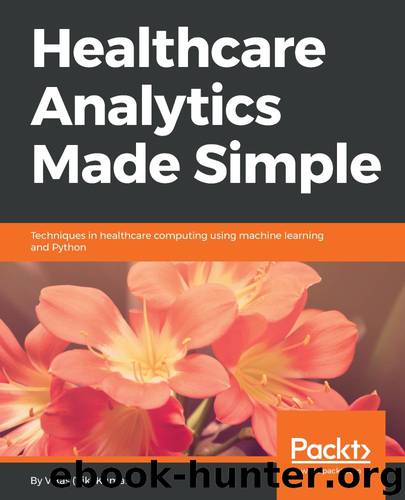Healthcare Analytics Made Simple: Techniques in healthcare computing using machine learning and Python by Vikas (Vik) Kumar

Author:Vikas (Vik) Kumar [Kumar, Vikas (Vik)]
Language: eng
Format: epub
Tags: COM018000 - COMPUTERS / Data Processing, COM021030 - COMPUTERS / Databases / Data Mining
Publisher: Packt Publishing
Published: 2018-07-30T23:00:00+00:00
Dictionaries
A dictionary is a common data structure in Python. It is used to store unidirectional mappings from keys to values. For example, if we wanted to create a dictionary that stored a list of patient names and their corresponding room numbers, we could use the following code:
rooms = {
'Smith': '141-A',
'Davis': '142',
'Williams': '144',
'Johnson': '145-B'
}
Let's talk about the preceding code snippet in more detail:
The names in the rooms dictionary are referred to as keys. The keys in a dictionary must be unique. To access them, we can use the keys() function, rooms.keys().
The room numbers in the rooms dictionary are referred to as values. To access all of the values, we can use the values() function, rooms.values(). To access an individual value, we just supply the name of its key in square brackets. For example, rooms['Smith'] will return '141-A'. For this reason, we say that a dictionary maps keys to their values.
To access a nested list of tuples that contains each key along with its corresponding value, we can use the items() function, rooms.items().
Dictionaries don't have to just be strings; in fact, the values can be any data type/structure. The keys can be particular variables such as integers or strings. While the values are mutable, the keys are immutable.
Dictionaries have no intrinsic order, so indexing and slicing by number is not supported.
Download
This site does not store any files on its server. We only index and link to content provided by other sites. Please contact the content providers to delete copyright contents if any and email us, we'll remove relevant links or contents immediately.
Deep Learning with Python by François Chollet(12875)
A Developer's Guide to Building Resilient Cloud Applications with Azure by Hamida Rebai Trabelsi(10176)
Hello! Python by Anthony Briggs(10124)
The Mikado Method by Ola Ellnestam Daniel Brolund(10013)
OCA Java SE 8 Programmer I Certification Guide by Mala Gupta(9980)
Dependency Injection in .NET by Mark Seemann(9518)
Hit Refresh by Satya Nadella(8993)
Algorithms of the Intelligent Web by Haralambos Marmanis;Dmitry Babenko(8522)
The Kubernetes Operator Framework Book by Michael Dame(8253)
Exploring Deepfakes by Bryan Lyon and Matt Tora(8037)
Practical Computer Architecture with Python and ARM by Alan Clements(7986)
Implementing Enterprise Observability for Success by Manisha Agrawal and Karun Krishnannair(7964)
Robo-Advisor with Python by Aki Ranin(7957)
Sass and Compass in Action by Wynn Netherland Nathan Weizenbaum Chris Eppstein Brandon Mathis(7915)
Grails in Action by Glen Smith Peter Ledbrook(7882)
Test-Driven iOS Development with Swift 4 by Dominik Hauser(7853)
Building Low Latency Applications with C++ by Sourav Ghosh(7847)
Svelte with Test-Driven Development by Daniel Irvine(7844)
The Well-Grounded Java Developer by Benjamin J. Evans Martijn Verburg(7771)
